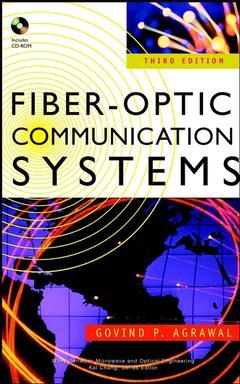Fiber-optic communication systems 3rd ed.
Langue : Anglais
Auteur : AGRAWAL Govind

This book provides a comprehensive, up-to-date account of fiber-optic communication systems in such a way as to serve as both a senior graduate level textbook and professional reference. The emphasis is on the physical understanding, but the engineering aspects are also discussed throughout the book. This volume focuses on the physics and technology behind fiber-optic communication systems while covering both the systems and components aspects. Updated to account for the advances that have taken place in the past four years, this new edition provides more details on the WDM technology and system design issues. As much recent materials as possible is included, so that students are exposed to the recent advances in this exciting field. The book can also serve as a reference text for researchers already engaged in or wishing to enter the field of optical fiber communications. A set of problems is included at the end of each chapter to help both teacher and student.
Preface.
1. Introduction.
1.1 Historical Perspective.
1.2 Basic Concepts.
1.3 Optical Communication Systems.
1.4 Lightwave System Components.
2. Optical Fibers.
2.1 Geometrical Optics Description.
2.2 Wave Propagation.
2.3 Dispersion in Single Mode Fibers.
2.4 Dispersion Induced Limitations.
2.5 Fiber Losses.
2.6 Nonlinear Optical Effects.
2.7 Fiber Manufacturing.
3. Optimal Transmitters.
3.1 Basic Concepts.
3.2 Light Emitting Diodes.
3.3 Semiconductor Lasers.
3.4 Control of Longitudinal Models.
3.5 Laser Characteristics.
3.6 Transmitter Design.
4. Optical Receivers.
4.1 Basic Concepts.
4.2 Common Photodetectors.
4.3 Receiver Design.
4.4 Receiver Noise.
4.5 Receiver Sensitivity.
4.6 Sensitivity Degradation.
4.7 Receiver Performance.
5. Lightwave Systems.
5.1 System Architectures.
5.2 Design Guidelines.
5.3 Long Haul Systems.
5.4 Sources of Power Penalty.
5.5 Computer Aided Design.
6. Optical Amplifiers.
6.1 Basic Concepts.
6.2 Semiconductor Optical Amplifiers.
6.3 Raman Amplifiers.
6.4 Erbium Doped Fiber Amplifiers.
6.5 System Applications.
7. Dispersion Management.
7.1 Need for Dispersion Management.
7.2 Precompensation Schemes.
7.3 Postcompensation Techniques.
7.4 Dispersion Compensating Fibers.
7.5 Optical Filters.
7.6 Fiber Bragg Gratings.
7.7 Optical Phase Conjugation.
7.8 Long Haul Lightwave Systems.
7.9 High Capacity Systems.
8 Multichannel Systems.
8.1 WDM Lightwave Systems.
8.2 WDM Components.
8.3 System Performance Issues.
8.4 Time Division Multiplexing.
8.5 Subcarrier Multiplexing.
8.6 Code Division Multiplexing.
9 Soliton Systems.
9.1 Fiber Solitons.
9.2 Soliton Based Communications.
9.3 Loss Managed Solitons.
9.4 Dispersion Managed Solitons.
9.5 Impact of Amplifier Noise.
9.6 High Speed Soliton Systems.
9.7 WDM Soliton Systems.
10 Coherent Lightwave Systems
10.1 Basic Concepts.
10.2 Modulation Formats.
10.3 Demodulation Schemes.
10.4 Bit Error Rate.
10.5 Sensitivity Degradation.
10.6 System Performance.
Appendix A,
System of Units.
Appendix B: Acronyms.
Appendix C: General Formula for Pulse Broadening.
Appendix D: Ultimate System Capacity.
Appendix E: Software Package.
Index.
1. Introduction.
1.1 Historical Perspective.
1.2 Basic Concepts.
1.3 Optical Communication Systems.
1.4 Lightwave System Components.
2. Optical Fibers.
2.1 Geometrical Optics Description.
2.2 Wave Propagation.
2.3 Dispersion in Single Mode Fibers.
2.4 Dispersion Induced Limitations.
2.5 Fiber Losses.
2.6 Nonlinear Optical Effects.
2.7 Fiber Manufacturing.
3. Optimal Transmitters.
3.1 Basic Concepts.
3.2 Light Emitting Diodes.
3.3 Semiconductor Lasers.
3.4 Control of Longitudinal Models.
3.5 Laser Characteristics.
3.6 Transmitter Design.
4. Optical Receivers.
4.1 Basic Concepts.
4.2 Common Photodetectors.
4.3 Receiver Design.
4.4 Receiver Noise.
4.5 Receiver Sensitivity.
4.6 Sensitivity Degradation.
4.7 Receiver Performance.
5. Lightwave Systems.
5.1 System Architectures.
5.2 Design Guidelines.
5.3 Long Haul Systems.
5.4 Sources of Power Penalty.
5.5 Computer Aided Design.
6. Optical Amplifiers.
6.1 Basic Concepts.
6.2 Semiconductor Optical Amplifiers.
6.3 Raman Amplifiers.
6.4 Erbium Doped Fiber Amplifiers.
6.5 System Applications.
7. Dispersion Management.
7.1 Need for Dispersion Management.
7.2 Precompensation Schemes.
7.3 Postcompensation Techniques.
7.4 Dispersion Compensating Fibers.
7.5 Optical Filters.
7.6 Fiber Bragg Gratings.
7.7 Optical Phase Conjugation.
7.8 Long Haul Lightwave Systems.
7.9 High Capacity Systems.
8 Multichannel Systems.
8.1 WDM Lightwave Systems.
8.2 WDM Components.
8.3 System Performance Issues.
8.4 Time Division Multiplexing.
8.5 Subcarrier Multiplexing.
8.6 Code Division Multiplexing.
9 Soliton Systems.
9.1 Fiber Solitons.
9.2 Soliton Based Communications.
9.3 Loss Managed Solitons.
9.4 Dispersion Managed Solitons.
9.5 Impact of Amplifier Noise.
9.6 High Speed Soliton Systems.
9.7 WDM Soliton Systems.
10 Coherent Lightwave Systems
10.1 Basic Concepts.
10.2 Modulation Formats.
10.3 Demodulation Schemes.
10.4 Bit Error Rate.
10.5 Sensitivity Degradation.
10.6 System Performance.
Appendix A,
System of Units.
Appendix B: Acronyms.
Appendix C: General Formula for Pulse Broadening.
Appendix D: Ultimate System Capacity.
Appendix E: Software Package.
Index.
Date de parution : 06-2002
Ouvrage de 546 p.
16x24 cm
Thèmes de Fiber-optic communication systems 3rd ed. :
© 2024 LAVOISIER S.A.S.



